An interview with Kate Forsyth, author of Bitter Greens
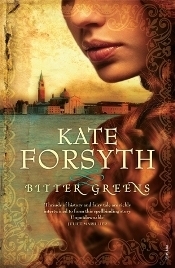 Kate Forsyth's deeply engrossing Bitter Greens carefully interweaves the stories of three women and their searches for power, freedom, and love across the span of two centuries.
Kate Forsyth's deeply engrossing Bitter Greens carefully interweaves the stories of three women and their searches for power, freedom, and love across the span of two centuries.At its center is Margherita, a girl in late 16th-century Venice, whose loving parents must fulfill a terrible bargain by giving her up to the red-haired sorceress known as La Strega Bella (the beautiful witch). Shut away in a distant tower with no means of escape, Margherita grows to womanhood alone. Her isolation is broken only by monthly visits from the witch, who announces her presence by calling for Margherita to let down her long hair.
A century later, Charlotte-Rose de la Force, a distant relative of the Sun King, learns about Margherita from an elderly nun. Outspoken and bold, Charlotte-Rose has been expelled from Versailles for her impious writings and rumors of romantic scandal and banished to a strict Benedictine abbey.
Intertwining with their tales, a third woman speaks about her life of passion, art, and black magic in early 1500s Venice. Selena Leonelli wasn't always a witch; she was born a whore's daughter, and she became the favored mistress of the Italian painter Tiziano. Her pursuit of eternal beauty comes at a price, though, and it's one that Margherita and her parents must pay.
While Kate Forsyth's take on the Rapunzel fairytale uses authentic history as a backdrop, her parallel story about the historical Charlotte-Rose — the author of one of the first Rapunzel retellings — is threaded with sinister enchantments. But despite the dark themes (this isn't a children's story!) the plot moves along with a light touch. Sweeping from the artistic extravagance of Renaissance Italy to the opulent, backbiting court of France's Louis XIV to the morbid discoveries made by Margherita in her tower overlooking Italy's Lake Garda, Bitter Greens is a rich, imaginative feat.
Kate is an Australian writer best known for her fantasy novels for adults and children; her work has always been inspired by history, although this is her first adult mainstream historical. I'd like to thank her for responding to my questions in such detail!
Each section of the novel begins with a quote from a different writer's interpretation of the Rapunzel tale. In addition to Charlotte-Rose de la Force's version, do you have any other favorite retellings, or ones that gave you special insight into how to proceed with your own?
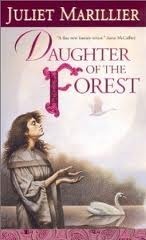 I loved all those Rapunzel poems! In a way, Rapunzel has inspired more poetry than she has novels. My favourite retelling of the tale has to be The Stone Cage by Nicholas Stuart Grey who is one of my all-time most beloved classic children’s authors. I also love The Glass Slipper by Eleanor Farjeon – I read both of these books at the age of 11 or 12, and they inspired my lifelong love of fairytale retellings. Fewer people write fairytale retellings books for adults - my favourites are Daughter of the Forest by Juliet Marillier – in fact, any book by Juliet Marillier – and Till We Have Faces by C.S. Lewis, a retelling of the Cupid and Psyche story.
I loved all those Rapunzel poems! In a way, Rapunzel has inspired more poetry than she has novels. My favourite retelling of the tale has to be The Stone Cage by Nicholas Stuart Grey who is one of my all-time most beloved classic children’s authors. I also love The Glass Slipper by Eleanor Farjeon – I read both of these books at the age of 11 or 12, and they inspired my lifelong love of fairytale retellings. Fewer people write fairytale retellings books for adults - my favourites are Daughter of the Forest by Juliet Marillier – in fact, any book by Juliet Marillier – and Till We Have Faces by C.S. Lewis, a retelling of the Cupid and Psyche story. The opening scene in which Charlotte-Rose is forced to leave Versailles and banished to the abbey at Gercy-en-Brie reminded me of Sarah Dunant's wonderful Sacred Hearts, in which a young Italian woman rails against being imprisoned in a nunnery against her will. (I'd be curious if you've read it!) In both your novel and hers, I was left with the strong impression of how few choices women had back then, in Europe of the 16th and 17th centuries. Why did you decide to make this a theme of your work?
I love Sarah Dunant’s books! Sacred Hearts came out when I was already well into the writing of Bitter Greens, and helped lay to rest some of my worry that you couldn’t write a book full of suspense and mystery when the key characters are locked away from the world, whether enclosed in a convent or imprisoned in a tower. I also re-read her novel set in Venice, In the Company of the Courtesan, which is another favourite of mine. I think it is indeed true that both my work and Sarah Dunant’s work highlights how few choices women had in the 16th & 17th centuries, but then I also think it is impossible to write a novel set in that period and not grapple with this issue. Women were truly powerless in a way that we find difficult to comprehend now. In 17th century France, a woman who gave away one of her brooches to thank a maid could be imprisoned with theft if her husband disapproved, since women were not permitted to own property of any kind, and were legally owned by the men in their lives, first their fathers and then their husbands. So you see, it was not that I decided to make this an issue, it was more a matter of being true to the times. One of the amazing things about Charlotte-Rose de la Force and her peers is that were in their own way proto-feminists, wishing for freedom and legal rights, but cruelly constrained by the world in which they lived. Writing stories and holding literary salons was the only way in which they could rebel.
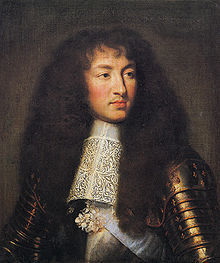 Louis XIV by LeBrun (1661)The tone of Bitter Greens is deliciously creepy and dark, keeping to the roots of the original fairy tale. I loved how you even worked black magic into Charlotte-Rose's fact-based story, with her involvement with the Affaire des Poisons at the Sun King's court. What about this gothic atmosphere appeals to you?
Louis XIV by LeBrun (1661)The tone of Bitter Greens is deliciously creepy and dark, keeping to the roots of the original fairy tale. I loved how you even worked black magic into Charlotte-Rose's fact-based story, with her involvement with the Affaire des Poisons at the Sun King's court. What about this gothic atmosphere appeals to you? My very first journal entry for Bitter Greens was written almost exactly seven years before it was published. I wrote ‘I’m very keen to write a Rapunzel novel – a dark, gothic retelling of a dark, gothic tale.’ From the very beginning, I knew I wanted to return to the story the charge that had been taken from it as it was reframed as a story for children, rather than one for adults. The original story has a lot of terror and cruelty in it – the father who will be maimed for stealing if he does not give up his newborn child, the sorceress who locks her away in a tower in the depths of a wild wood, the climbing of the hair (which must have hurt terribly), the heroine giving birth to twins all by herself in the wilderness, and, of course, the blinding of the prince by thorns. I believe passionately that you need darkness in stories in order to make the brightness more radiant. Rapunzel is a story about a girl who survives a terrible form of abuse, and who redeems all those about her with her great capacity for love and forgiveness. To me, this darkness was the key to the story, and so one I felt strongly needed to be explored.
I also felt that the story had to be written as if it was true, as if it had really happened, so that the distancing effect of far, far away and long, long ago could be dismantled. This is why I chose to write it as a historical novel, rather than a fantasy. I decided to try and find the first version of Rapunzel, which led me to stumble upon the extraordinary story of Charlotte-Rose de la Force, the 17th century French writer who wrote the tale that we best know. It took me years to track down her life story, and many of it is very brief, without much detail. For example, I knew that Charlotte-Rose ‘had come to the attention of the king’ during the infamous Affaire des Poisons, and also that court gossip accused her of trying to seduce the Marquis de Nesle with black magic (I discovered the anecdote about the silken bag containing toads’ legs in the letters of Liselotte, the Princess of Palatine) – this was simply too good a story not to use! In general, many of the key scenes in Charlotte-Rose’s life are based on true-life accounts of her life – for example, the nightcap left in her room by the actor Michel Baron. I used these anecdotes as pegs around which I wove my fancy.
I cannot tell you why I like such stories. I’ve always been drawn to the magical and the strange and the wondrous, and history is full of such tales.
Your depiction of Louis XIV shows him as self-centered, oversexed, contemptuous, and cruel; he's a larger-than-life figure in many ways, but while his court and mode of dress are ornate and glamorous, his character isn't glamorized at all. How did your depiction of him come about?
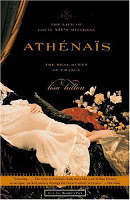 I read every single book I could find about Louis XIV and his court and his mistresses. There was such a wealth of material! The best books were Love & Louis XIV: The Women in the Life of the Sun King by Antonia Fraser, Athenais: The Life of Louis XIV’s Mistress by Lisa Hilton, The Splendid Century: Life in the France of Louis XIV by W.H. Lewis, and The Affair of the Poisons: Murder, Infanticide and Satanism at the Court of Louis XIV by Anne Somerset. They were very illuminating about the court of the Sun King, and what it must’ve been like to live there as a young woman. I think Charlotte-Rose was pleased she wasn’t pretty!
I read every single book I could find about Louis XIV and his court and his mistresses. There was such a wealth of material! The best books were Love & Louis XIV: The Women in the Life of the Sun King by Antonia Fraser, Athenais: The Life of Louis XIV’s Mistress by Lisa Hilton, The Splendid Century: Life in the France of Louis XIV by W.H. Lewis, and The Affair of the Poisons: Murder, Infanticide and Satanism at the Court of Louis XIV by Anne Somerset. They were very illuminating about the court of the Sun King, and what it must’ve been like to live there as a young woman. I think Charlotte-Rose was pleased she wasn’t pretty! The Rapunzel tale doesn't traditionally include the witch's side of the story. At what point did you decide to write it, and to make her Titian's (Tiziano's) beautiful red-haired mistress?
Stories grow in strange and marvellous ways, and one of the things I love most about being a writer is this sense that I don’t create the stories so much as discover them, as if they were always waiting there for someone to come and find them and tell them to the world. I’m just glad it was me that discovered this story!
The witch’s story is one of those discoveries. Even as young child I’d always been puzzled by her actions. Why? I’d think. Why does she lock Rapunzel away?
As I began to work on the novel, I began researching its origins and that was when I read about ‘Petrosinella’, one of the earliest Maiden in the Tower tales, which was written by a Neapolitan, Giambattista Basile, when he was working as a soldier for the Venetian Republic in the 1600s. I immediately saw that Venice would be a wonderful setting for a Rapunzel tale – all those shadowy alleys and secret walled gardens and high towers – and so I began to read everything I could find about life in Renaissance Venice. I stumbled across a book called The Honest Courtesan – Veronica Franco, Citizen and Writer in 16th century Venice by Margaret F. Rosenthal in a second-hand bookshop and bought it for about three dollars. I found it fascinating and at once began to imagine how the sorceress of my tale could have been a courtesan. One thing that book gave me was the possible why. It describes the gang rape of a courtesan Angela Zaffetta by eighty men, an apparently common form of revenge in 16th century Venice, which I found very shocking. I thought about that for a long time, while I was working on different parts of the book, and the story of Serena, La Bella Strega, slowly came to me.
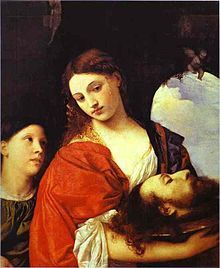 Salome by Titian (ca. 1515)
Salome by Titian (ca. 1515)Then, quite some time later, I was looking through my art books for a book to help my son do a project on William Blake, and I found my book on Titian, which I had not looked at for a very long time. Ah, I thought, wasn’t he Venetian? I pulled it out, and flicked through the colour plates, and saw the face that he painted again and again, and remembered I had read somewhere that it was his mistress that he painted, and that she had been a courtesan. At once everything just clicked into place in my mind. It was such a magical revelation. I spent the next few weeks and even months looking at all Titian’s paintings, reading everything I could find on him, and compiling a time line.
It was simply serendipity.
You've added many creative touches to a fairy tale that everyone believes they know. How did you come up with the (rather grisly!) explanation for how Rapunzel's amazingly long hair came to be?
That was a problem I pondered for a long time. If I was to tell Rapunzel as a historical novel, I couldn’t simply have her hair grow so long magically. Besides, I never understood why her hair had to be so impossibly long. Why not simply climb up stairs or a ladder or a rope? And the motif of the impossibly long hair is a key motif to the story – take it away and you are no longer telling Rapunzel. I wondered and worried about it for a long time, and read lots of books and blogs about hair, and its symbolic meaning, and the sometimes odd fetishes people have about it – they love red hair, or hate it violently, or they love long hair, or no hair, or they like to eat it, which is potentially life-threatening since hair cannot be digested. Anyway, one day, I was out walking at my brother’s farm, and my mind was drifting along the story quite without any purpose in mind, and suddenly the idea came to me. It all fitted so well, it was like finding that missing piece of a jigsaw that you’ve been searching for such a long time. I ran home, and my brother thought I must’ve seen a snake because I never run, but I just panted, ‘no ... had an idea ... where’s my notebook ...’ and that was it.
Bitter Greens has stories nestled within stories, with Margherita's tale, Selena's narrative, and Charlotte-Rose's story framing the others... not just her time at the abbey in 1697, but it also looks back to her childhood and important episodes during her years at Versailles. Everything fits together beautifully, but I can't imagine the challenge of structuring it all! How did you keep everything straight in your mind?
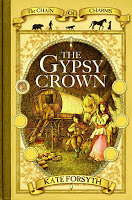 I began by wanting to rewrite Rapunzel, which led me to Giambattista Basile and the idea of Renaissance Venice as my setting. I did a lot of reading and research into that period, and I kept a notebook that chronicles all my notes and ideas and wild jottings. But then, quite a long way down the track, I came across the story of Charlotte-Rose de la Force, which set my imagination on fire. Eventually I began a second notebook for her story, with all my notes on life at the court of the Sun-King, and life in 17th century convents and so forth. I built a framework for the story, with ideas about how and when the key events in each story could touch each other, and then I began to write Charlotte-Rose’s story, which was the most complex and difficult to write. I wrote her tale from beginning to end without pause, noting key places to break the narrative. I then began Margherita’s story, and wrote it in the same way, from first line to last line, inserting each section into Charlotte-Rose’s story at the key break points. Only then did I turn my attention to the story of the witch.
I began by wanting to rewrite Rapunzel, which led me to Giambattista Basile and the idea of Renaissance Venice as my setting. I did a lot of reading and research into that period, and I kept a notebook that chronicles all my notes and ideas and wild jottings. But then, quite a long way down the track, I came across the story of Charlotte-Rose de la Force, which set my imagination on fire. Eventually I began a second notebook for her story, with all my notes on life at the court of the Sun-King, and life in 17th century convents and so forth. I built a framework for the story, with ideas about how and when the key events in each story could touch each other, and then I began to write Charlotte-Rose’s story, which was the most complex and difficult to write. I wrote her tale from beginning to end without pause, noting key places to break the narrative. I then began Margherita’s story, and wrote it in the same way, from first line to last line, inserting each section into Charlotte-Rose’s story at the key break points. Only then did I turn my attention to the story of the witch.My original plan had been to interweave the three stories like a braid, so that the thematic structure of the book symbolically reflected the key motif of the hair. However, Charlotte-Rose’s story had grown so long and become the dominant narrative, and I knew the witch’s story would be much shorter. I thought of it as being the dark heart of the novel, and so that was how I structured it. Once again I wrote the witch’s story from beginning to end without pause, and then I found the best place to put it. It’s a key turning point in the novel. The two stories –Charlotte-Rose and Margherita’s points of view – spin into it, and then they spin out of it, but with all the reader’s expectations and understanding changed.
What led you to write a historical novel for adults (rather than history-tinged fantasy) at this point in your career?
I have always loved reading historical fiction, it’s my favourite genre. Basically I’ll read any type of story if it’s set in the past – historical romance, historical mystery, historical fantasy, historical biography – I love them all. And I write what I love to read. Every book I have ever written has been rich in history, magic, intrigue and romance. In some books, the balance is more towards history, like in my historical novel for children, The Gypsy Crown. In others, the focus is more on magic, like in the Witches of Eileanan fantasy series. For me, the shape and mood of the novel is always shaped by the story itself. Bitter Greens felt right to me told in this way, with a strong historical setting and the inclusion of real life characters such as the artist Titian and the fairytale tellers, Charlotte-Rose de la Force and Charles Perrault.
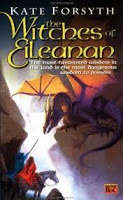 Earlier you'd told me that Bitter Greens was the creative component of a PhD you're undertaking at the University of Technology in Sydney. What's it like to write a novel as part of an academic degree? How does the process differ from what you're used to?
Earlier you'd told me that Bitter Greens was the creative component of a PhD you're undertaking at the University of Technology in Sydney. What's it like to write a novel as part of an academic degree? How does the process differ from what you're used to? One of my earliest published novels, Full Fathom Five, was written as the thesis for my Masters degree in Creative Writing, and I wrote the first two books of the Witches of Eileanan series whilst studying the same degree, so it was not a new experience for me. The primary difference is having to show early work to someone and receive critical appraisal of it. I do find that difficult. I don’t like to show anyone my work until I have had a chance to edit and polish and cut and change it substantially. However, I was eager to learn as much as I could, and so I welcomed my supervisor’s insights into my work. In general, the secret to writing a novel is discipline (particularly one that is so big and complex). I think undertaking a doctorate is all about discipline as well – it just means taking on a double burden of work for a while.
~
Bitter Greens was published by Random House Australia in April at $32.99 Aus (trade pb, 554pp). For readers outside Australia, I can personally recommend Fishpond, which offers free shipping worldwide. Visit Kate Forsyth's website for more details on her inspirations for Bitter Greens.
Published on May 25, 2012 17:00
No comments have been added yet.



